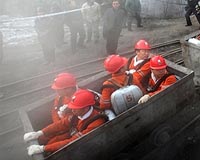| . |  |
. |
Beijing (UPI) Nov 23, 2009 Poor management and inadequate safety precautions were blamed for a massive China coalmine blast that so far has claimed 104 lives, safety officials and investigators said. The blast that ripped through Xinxing mine in Heilongjiang province Saturday started with a gas leak in one of the shafts, said Luo Lin, head of the State Administration of Work Safety, state news agency Xinhua reports. Because of poor ventilation, gas quickly poured into the main tunnel and triggered an explosion that shook 28 of the 30 mining platforms in operation, he said. The blast was powerful enough to be felt 6 miles away. Of the 528 miners who were working in the pit when the blast occurred, 420 managed to escape. As of 2:30 a.m. Monday, four workers were still trapped underground, state media reported. Luo said management of the mine was to blame for failing to evacuate the workers promptly after an extraordinarily high gas density was detected in the pit. "The accident has again revealed many problems in colliery management -- it's a lesson we must all learn," Luo said. Three of the mine's officials, including its director, have been removed from their posts, CCTV reports. Xinxing is run by Longmei Mining Holding Group Co., a state-owned mining company with an annual output of 56 million tons of coal. According to its Web site, Longmei ranked 12th among China's 100 leading mining companies and seventh in terms of coal output. A high-gas coal facility, Xinxing has been operating for 84 years and has an annual production capacity of 1.45 million tons. Chinese President Hu Jintao and Premier Wen Jiabao sent Vice Premier Zhang Dejiang to the scene Saturday to oversee rescue efforts. China's mine industry claims more than 3,000 lives each year. The blast was China's worst mining disaster in nearly two years. A blast at a state-run mine in Shanxi province in February killed 77 people. In December 2007 an explosion in Shanxi killed 105 people, and 203 died in Liaoning province in 2005. Yet another coalmine blast occurred Sunday in Huaihua in central China's Hunan province, killing at least six, Xinhua reports. In an effort to improve safety, the government has strengthened its effort to shut down smaller mines, most of which are illegal. Yet official figures show that illegal mines still account for four out of five of China's 16,000 collieries. In the first half of this year 1,175 people died in officially recorded coalmine accidents, a fall of 18.4 percent from a year ago. While state-owned mines have better management compared with private mines, there are still loopholes, said Fang Xinqiu, an associate professor at the China University of Mining and Technology, China's Global Times reports. Fang cited poor management and inaction by mine leaders for the deaths at Xinxing. Xie Yaoshe, also an associate professor with the university, said coalmine owners in China are more willing to pay fines than to invest on workplace safety equipment or personnel training. Share This Article With Planet Earth
Related Links Surviving the Pits
 Anger builds as China mine toll hits 104
Anger builds as China mine toll hits 104Hegang, China (AFP) Nov 23, 2009 Relatives of victims angrily demanded answers Monday as the death toll from China's worst mining disaster in two years climbed to 104 and hopes of finding more survivors faded. Rescuers recovered 12 more bodies, a spokesman for the mine in the northeastern province of Heilongjiang said, leaving four miners still unaccounted for after Saturday's huge blast. A preliminary investigation ... read more |
|
| The content herein, unless otherwise known to be public domain, are Copyright 1995-2009 - SpaceDaily. AFP and UPI Wire Stories are copyright Agence France-Presse and United Press International. ESA Portal Reports are copyright European Space Agency. All NASA sourced material is public domain. Additional copyrights may apply in whole or part to other bona fide parties. Advertising does not imply endorsement,agreement or approval of any opinions, statements or information provided by SpaceDaily on any Web page published or hosted by SpaceDaily. Privacy Statement |